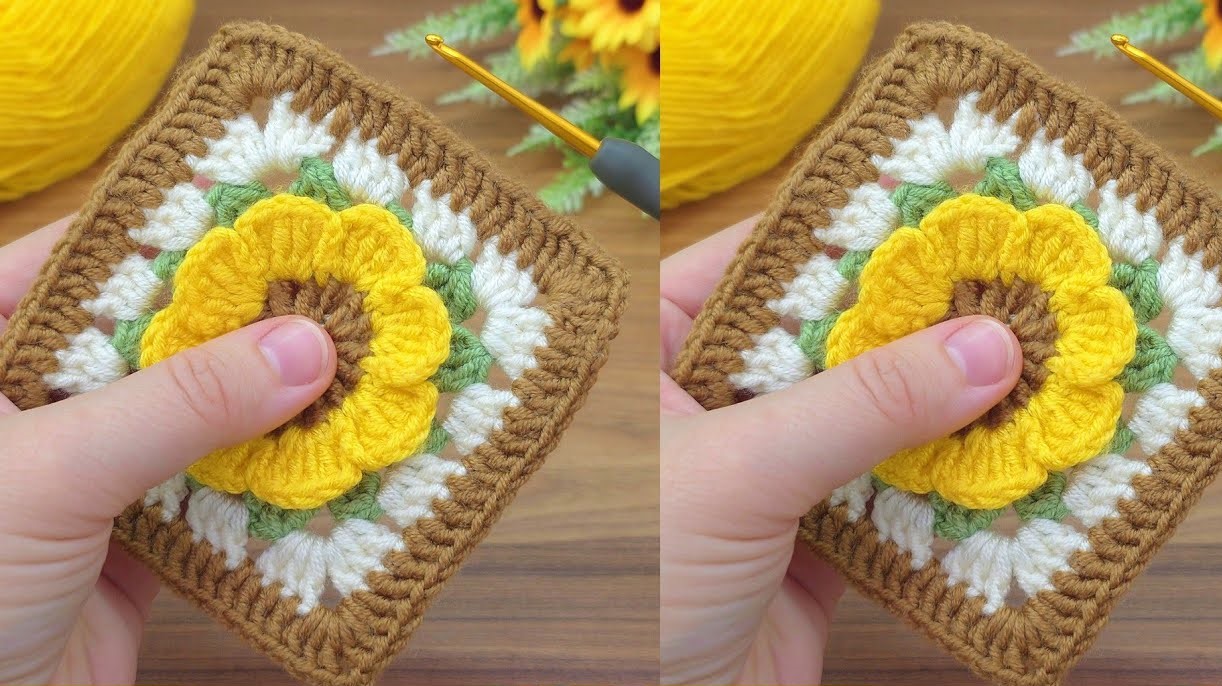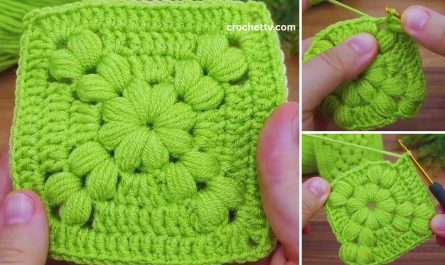Creating a Sunflower Crochet Square Baby Blanket is a charming project that’s surprisingly easy for ambitious beginners. This tutorial will break down how to make individual sunflower squares and then how to join them to form a beautiful, cozy blanket. We’ll focus on simple stitches and clear instructions to ensure a smooth and enjoyable crafting experience.
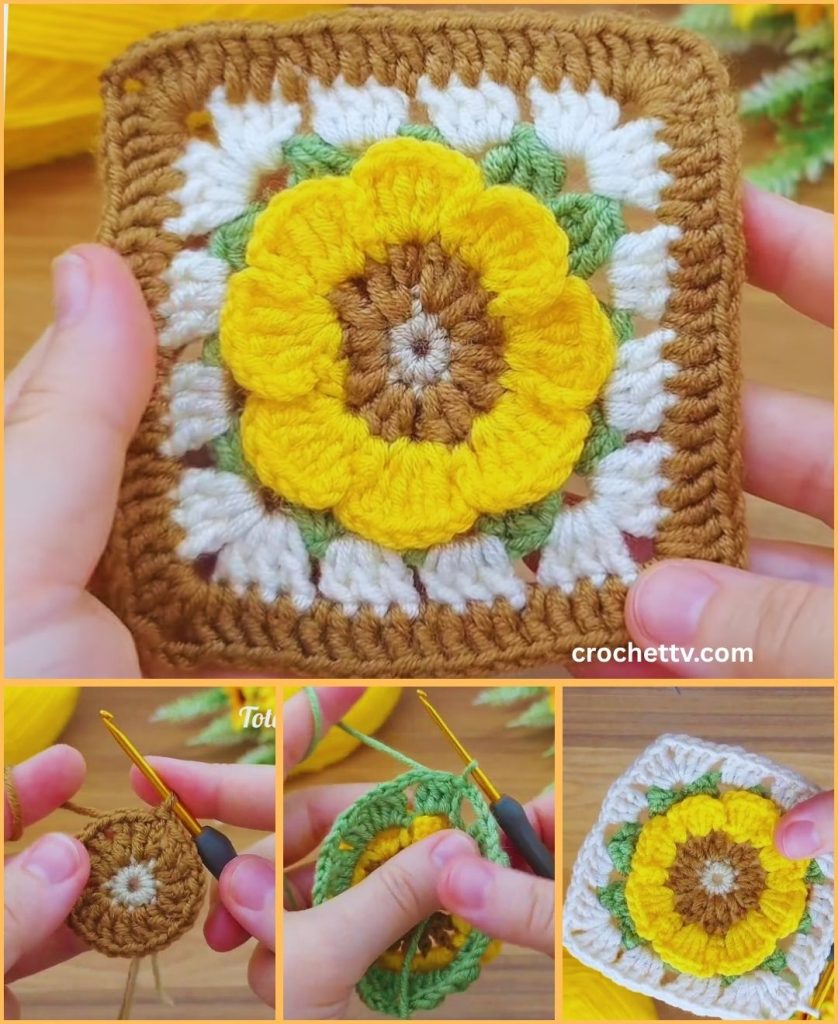
Skill Level: Easy (Great for Ambitious Beginners!)
This project is perfect if you’re ready to learn or practice:
- Magic Ring (MR) / Chain-2 Start: For a tight, seamless center.
- Chain (ch): The fundamental starting stitch.
- Slip Stitch (sl st): For joining stitches and rounds neatly.
- Single Crochet (sc): A compact stitch.
- Half Double Crochet (hdc): A medium-height stitch.
- Double Crochet (dc): A taller stitch, perfect for petals and the main body of the square.
- Treble Crochet (tr): An even taller stitch (optional, sometimes used for more defined petals).
- Working in the round: Crocheting in a circular motion.
- Working in rows: For the border.
- Increasing: Making your work wider.
- Changing Colors: Essential for the sunflower effect.
- Joining Squares: A simple method for connecting your motifs.
- Fastening off: Securing your yarn.
- Weaving in ends: The crucial final step for a polished finish.
Finished Blanket Dimensions (Approximate):
The size of your blanket depends on the number of squares you make. A common baby blanket size is around 30×40 inches (75×100 cm). Each sunflower square will be approximately 6×6 inches (15×15 cm).
To achieve a 30×40 inch blanket, you’d need approximately:
- 5 squares wide (5 x 6 inches = 30 inches)
- 7 squares long (7 x 6 inches = 42 inches – close enough to 40)
- Total Squares Needed: 35 squares
Of course, you can make it larger or smaller by adjusting the number of squares.
Materials You’ll Need:
Gathering your supplies ensures a smooth and enjoyable crocheting session!
- Yarn:Worsted Weight (Medium #4) Acrylic Yarn is highly recommended for baby blankets. It’s soft, durable, easy to wash, and comes in a huge range of colors.
- Color A (Sunflower Center): A medium to dark brown (e.g., about 150-200 yards for 35 squares).
- Color B (Sunflower Petals): A bright yellow (e.g., about 200-250 yards for 35 squares).
- Color C (Square Background/Greenery): A medium green (e.g., about 250-300 yards for 35 squares).
- Color D (Border/Joining Color): A white, cream, or a complementary color to tie it all together (e.g., about 300-400 yards).
- Note: Yarn quantities are estimates. Always buy a bit extra to be safe!
- Crochet Hook: Size H/5.0mm. This size works well with worsted weight yarn for a soft, yet not too open, fabric.
- Yarn Needle (Tapestry Needle): Essential for weaving in ends and joining squares.
- Scissors: Any sharp pair for cutting your yarn.
- Stitch Markers (Optional but Recommended): Helpful for marking corners or the first stitch of a round.
Let’s Crochet Your Sunflower Baby Blanket!
We’ll break this down into three main parts:
- Making the individual Sunflower Square.
- Joining the squares together.
- Adding a border to the blanket.
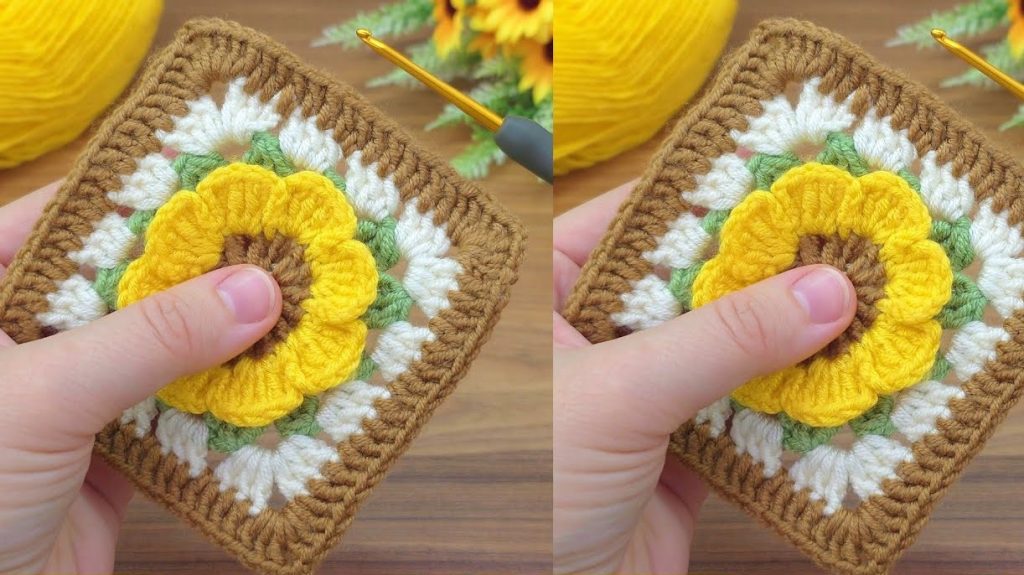
Part 1: Crocheting the Individual Sunflower Square
Each square will be worked in rounds, changing colors to create the sunflower effect. You’ll make the center, then the petals, and then build the square shape around the sunflower.
Abbreviations Used:
- MR: Magic Ring
- ch: chain
- sl st: slip stitch
- sc: single crochet
- hdc: half double crochet
- dc: double crochet
- tr: treble crochet (yarn over twice, insert hook, yarn over, pull up loop, [yarn over, pull through 2 loops] 3 times)
- FO: fasten off
Sunflower Square Pattern (Make 35 or your desired number)
Start with Color A (Brown – for the center)
- Round 1 (Center): Make a Magic Ring. Chain 2 (counts as first hdc). Work 9 hdc into the MR. Join with a slip stitch (sl st) to the top of the beginning ch 2. Pull the MR tight to close. (10 hdc)
- Alternative Start: Chain 3, join with sl st to first ch to form a ring. Ch 2, work 9 hdc into the ring. Join with sl st to top of ch 2.
- Round 2 (Dark Center): Chain 2 (counts as first hdc). Work 1 hdc into the same stitch. Work 2 hdc into each of the remaining stitches around. Join with a sl st to the top of the beginning ch 2. (20 hdc)
- Fasten off (FO) Color A.
Switch to Color B (Yellow – for the petals)
- Round 3 (Petals):
- Join Color B with a sl st into any stitch.
- *Chain 2. Work 1 double crochet (dc) into the same stitch. Work 1 treble crochet (tr) into the next stitch. Work 1 dc into the next stitch. Chain 2. Sl st into the next stitch.* (This creates one petal cluster).
- Repeat from * to * 4 more times around (for a total of 5 petals). After the last sl st, you’ll be at the end of the round.
- FO Color B.
- Note: If you want slightly more defined petals, you can use the following: *Chain 2. (1 dc, 1 tr, 1 dc) into the same stitch. Sl st into the next stitch.* Repeat around. This makes the petal “pop” a bit more.
Switch to Color C (Green – for the square background)
- Round 4 (First Square Layer):
- Join Color C with a sl st into any sl st space between two petals from Round 3.
- Chain 3 (counts as first dc). Work 2 dc into the same space. Chain 2 (this creates a corner). Work 3 dc into the same space. (This is your first corner cluster).
- *Chain 1. Skip the next petal. Work (3 dc, ch 2, 3 dc) into the next sl st space between petals.*
- Repeat from * to * 3 more times. After the last corner, Chain 1. Join with a sl st to the top of the beginning ch 3.
- FO Color C.
- Round 5 (Second Square Layer):
- Join Color C with a sl st into any ch-2 corner space from Round 4.
- Chain 3 (counts as first dc). Work 2 dc into the same corner space. Chain 2. Work 3 dc into the same corner space. (This is your first new corner).
- *Work 3 dc into the next ch-1 space.
- Work (3 dc, ch 2, 3 dc) into the next ch-2 corner space.*
- Repeat from * to * 2 more times. Work 3 dc into the last ch-1 space.
- Join with a sl st to the top of the beginning ch 3.
- FO Color C.
- Round 6 (Final Square Layer for Size):
- Join Color D (or continue with Color C if you prefer) with a sl st into any ch-2 corner space from Round 5.
- Chain 3 (counts as first dc). Work 2 dc into the same corner space. Chain 2. Work 3 dc into the same corner space.
- *Work 3 dc into each of the next two spaces (these are the spaces created by the 3-dc clusters from the previous round).
- Work (3 dc, ch 2, 3 dc) into the next ch-2 corner space.*
- Repeat from * to * 2 more times. Work 3 dc into each of the next two spaces.
- Join with a sl st to the top of the beginning ch 3.
- FO Color D.
You have now completed one Sunflower Square! Repeat this process for all 35 (or your desired number) of squares.
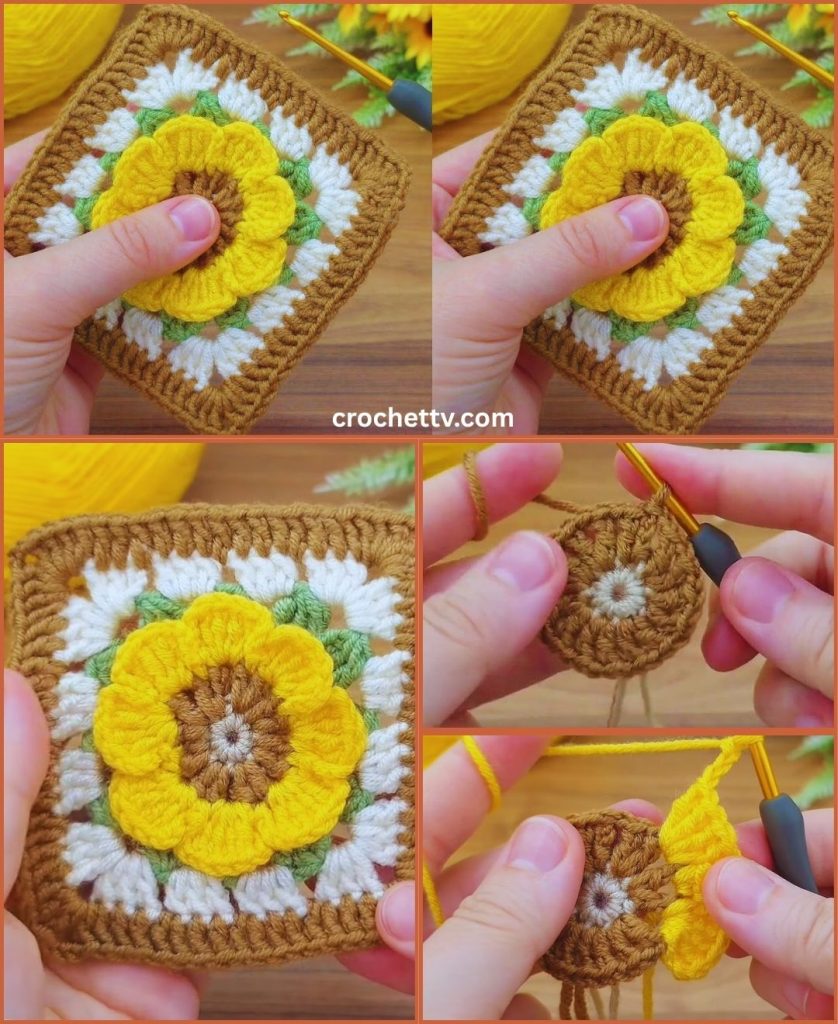
Part 2: Joining the Squares
There are many ways to join crochet squares. For beginners, a simple slip stitch join or a single crochet join from the right side (front) of the blanket are easy and create a neat seam.
Method 1: Single Crochet Join (Creates a visible ridge)
- Lay out your squares on a flat surface in the desired arrangement (e.g., 5 squares wide by 7 squares long). This helps you visualize the pattern and avoid mistakes.
- Take two squares you want to join. Place them right sides facing up.
- Join Color D (your joining color) with a sl st into the corner stitch of both squares.
- Chain 1.
- Working through both loops of both squares simultaneously, single crochet across the edge, matching stitch for stitch.
- When you reach the end of the first side, chain 1 (this can help with corner transition).
- Continue joining all squares into long strips (e.g., 7 squares long).
- Once you have all your horizontal strips joined, lay them out again.
- Now, join the strips together vertically using the same single crochet join method. Take two strips, align them, and sc through both loops, matching stitches and the chain-1 spaces at the strip intersections.
Method 2: Mattress Stitch (Invisible Join – for a flatter finish)
This method uses your yarn needle and creates a nearly invisible seam. It’s a bit more time-consuming but offers a beautiful finish.
- Lay your squares right sides up, side-by-side, so the edges you want to join are touching.
- Thread Color D onto your yarn needle.
- Working from bottom to top along the edges you want to join, insert your needle under the front loop of the stitch on one square, then under the front loop of the corresponding stitch on the other square.
- Continue this “ladder stitch” motion, going back and forth between the two squares, pulling gently to close the seam.
- Repeat for all squares, joining them into strips first, then joining the strips.
Part 3: Adding the Border
A border gives your blanket a finished, polished look and adds extra warmth. We’ll use simple single crochet and double crochet rows for a sturdy and appealing edge.
Using Color D (or a new border color if desired)
- Attach Yarn: Join Color D with a sl st into any corner stitch of your assembled blanket.
- Round 1 (Single Crochet Border):
- Chain 1 (does not count as a stitch).
- Work 2 single crochet (sc) into the corner stitch.
- Work 1 sc into each stitch around the entire blanket. When you reach a corner, work 3 sc into that corner stitch. When you reach the joined seams between squares, try to work 1-2 sc stitches into the actual seam to keep the stitch count even and prevent gaps.
- Join with a sl st to the first sc of the round.
- Round 2 (Double Crochet Border):
- Chain 3 (counts as first dc).
- Work 1 dc into each stitch around the blanket.
- In each corner, work 3 dc into the center sc of the 3-sc corner from the previous round (or simply work 3 dc into the corner stitch if it’s more straightforward for you).
- Join with a sl st to the top of the beginning ch 3.
- Round 3 (Single Crochet Border – Optional):
- Chain 1 (does not count as a stitch).
- Work 1 sc into each stitch around.
- Work 3 sc into each corner stitch (the middle dc of the 3-dc corner from the previous round).
- Join with a sl st to the first sc of the round.
- Fasten off, leaving a 6-inch tail.
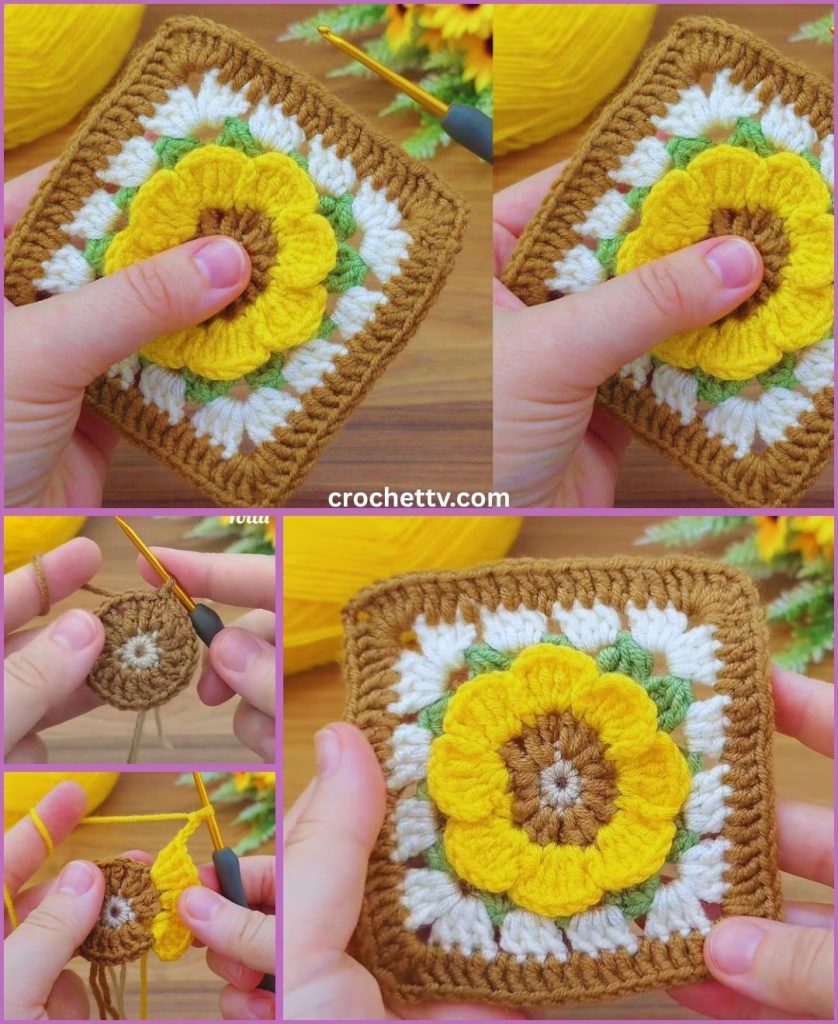
Part 4: Final Finishing Touches
This stage is crucial for making your blanket look polished and durable.
- Weave in All Ends (Meticulously!):
- This is often the most time-consuming part, but it’s essential for a beautiful and long-lasting blanket. You’ll have many tails from starting each square, changing colors, joining, and the border.
- Thread each yarn tail onto your yarn needle.
- How to Weave Neatly: Insert the needle into existing stitches of the same color for at least 3-4 inches (7.5-10 cm). Try to follow the path of existing stitches to make it invisible. To make it extra secure and prevent unraveling, subtly change direction (e.g., weave along a stitch, then turn and weave back through some of the same stitches diagonally or perpendicularly) to “lock” the tail in place.
- Once secured, trim any excess yarn close to the fabric, being careful not to cut any of your actual crocheted stitches.
- Blocking (Highly Recommended!):
- Blocking is a process that can significantly improve the shape of your squares and the overall drape of your blanket, making it look much more professional and evening out any tension inconsistencies.
- Method for Acrylic Yarn:
- Steam Blocking: Lay your finished blanket flat on a heat-safe surface (like an ironing board or a mat). Hold a steam iron just above the blanket (do NOT touch the iron to the yarn, as acrylic can melt). Allow the steam to penetrate the fibers. Gently pat or shape the squares into place. Let it cool and dry completely.
- Wet Blocking: Submerge the blanket in cool water for about 20 minutes with a bit of gentle soap (optional). Gently squeeze out excess water (do not wring). Lay it flat on towels or blocking mats, gently stretching and pinning the squares and overall blanket into their desired shape. Allow it to air dry completely.
Congratulations! You’ve successfully crocheted an amazing and beautiful Sunflower Crochet Square Baby Blanket! This is a fantastic accomplishment, showcasing your growing skills and creativity.
Who will be the lucky recipient of this cozy, handmade treasure?

